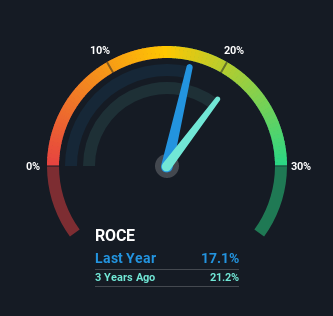- India
- /
- Metals and Mining
- /
- NSEI:RAMASTEEL
There Are Reasons To Feel Uneasy About Rama Steel Tubes' (NSE:RAMASTEEL) Returns On Capital

If you're not sure where to start when looking for the next multi-bagger, there are a few key trends you should keep an eye out for. In a perfect world, we'd like to see a company investing more capital into its business and ideally the returns earned from that capital are also increasing. Basically this means that a company has profitable initiatives that it can continue to reinvest in, which is a trait of a compounding machine. However, after investigating Rama Steel Tubes (NSE:RAMASTEEL), we don't think it's current trends fit the mold of a multi-bagger.
Return On Capital Employed (ROCE): What is it?
For those that aren't sure what ROCE is, it measures the amount of pre-tax profits a company can generate from the capital employed in its business. The formula for this calculation on Rama Steel Tubes is:
Return on Capital Employed = Earnings Before Interest and Tax (EBIT) ÷ (Total Assets - Current Liabilities)
0.17 = ₹225m ÷ (₹2.5b - ₹1.2b) (Based on the trailing twelve months to June 2021).
So, Rama Steel Tubes has an ROCE of 17%. That's a relatively normal return on capital, and it's around the 15% generated by the Metals and Mining industry.
Check out our latest analysis for Rama Steel Tubes

While the past is not representative of the future, it can be helpful to know how a company has performed historically, which is why we have this chart above. If you're interested in investigating Rama Steel Tubes' past further, check out this free graph of past earnings, revenue and cash flow.
The Trend Of ROCE
When we looked at the ROCE trend at Rama Steel Tubes, we didn't gain much confidence. Over the last five years, returns on capital have decreased to 17% from 38% five years ago. Although, given both revenue and the amount of assets employed in the business have increased, it could suggest the company is investing in growth, and the extra capital has led to a short-term reduction in ROCE. And if the increased capital generates additional returns, the business, and thus shareholders, will benefit in the long run.
On a side note, Rama Steel Tubes has done well to pay down its current liabilities to 47% of total assets. That could partly explain why the ROCE has dropped. What's more, this can reduce some aspects of risk to the business because now the company's suppliers or short-term creditors are funding less of its operations. Since the business is basically funding more of its operations with it's own money, you could argue this has made the business less efficient at generating ROCE. Either way, they're still at a pretty high level, so we'd like to see them fall further if possible.
The Bottom Line On Rama Steel Tubes' ROCE
In summary, despite lower returns in the short term, we're encouraged to see that Rama Steel Tubes is reinvesting for growth and has higher sales as a result. And long term investors must be optimistic going forward because the stock has returned a huge 110% to shareholders in the last five years. So while the underlying trends could already be accounted for by investors, we still think this stock is worth looking into further.
One more thing: We've identified 4 warning signs with Rama Steel Tubes (at least 2 which can't be ignored) , and understanding them would certainly be useful.
For those who like to invest in solid companies, check out this free list of companies with solid balance sheets and high returns on equity.
New: AI Stock Screener & Alerts
Our new AI Stock Screener scans the market every day to uncover opportunities.
• Dividend Powerhouses (3%+ Yield)
• Undervalued Small Caps with Insider Buying
• High growth Tech and AI Companies
Or build your own from over 50 metrics.
This article by Simply Wall St is general in nature. We provide commentary based on historical data and analyst forecasts only using an unbiased methodology and our articles are not intended to be financial advice. It does not constitute a recommendation to buy or sell any stock, and does not take account of your objectives, or your financial situation. We aim to bring you long-term focused analysis driven by fundamental data. Note that our analysis may not factor in the latest price-sensitive company announcements or qualitative material. Simply Wall St has no position in any stocks mentioned.
Have feedback on this article? Concerned about the content? Get in touch with us directly. Alternatively, email editorial-team (at) simplywallst.com.
About NSEI:RAMASTEEL
Rama Steel Tubes
Engages in the manufacture and trading of steel pipes and tubes, and rigid poly vinyl chloride and galvanized iron pipes in India and internationally.
Excellent balance sheet and slightly overvalued.
Similar Companies
Market Insights
Community Narratives



